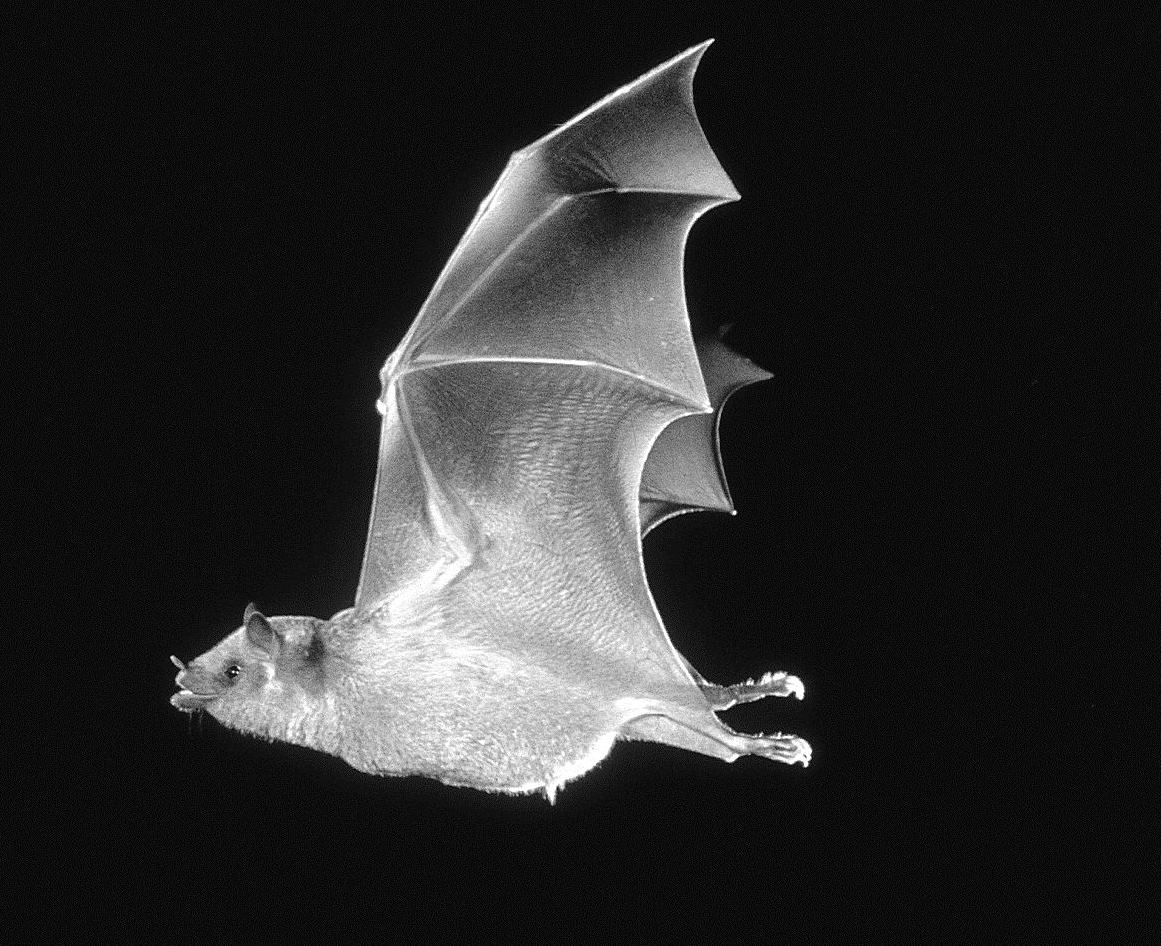MEXICAN LONG-NOSED BAT
Leptonycteris nivalis (Saussure 1860)
Order Chiroptera : Family Phyllostomidae
DESCRIPTION. A medium-sized bat with short ears, no tail, and a distinct nasal leaf; forearm furred above at elbow; upperparts drab brown, the hairs white basally; underparts pale drab, tips of hairs silvery. Dental formula: I 2/2, C 1/1, Pm 2/3, M 2/2 × 2 = 30. Averages for external measurements: total length, 83 mm; foot, 17 mm; ear, 15 mm; forearm, 58 mm. Weight, 24 g.

DISTRIBUTION. A highly colonial, cave-dwelling, migratory species, this bat has been recorded in the United States only in southwestern New Mexico and Trans-Pecos Texas, where it has been captured in Big Bend National Park, Brewster County, and the Chinati Mountains of Presidio County. Mexican long-nosed bats occupy areas in Texas and New Mexico from June to August, after which time they move out of the United States to winter in Mexico.

SUBSPECIES. Monotypic species.
HABITS. This is a colonial, cave-dwelling bat that usually inhabits deep caverns. The only
known records of these bats in the United States are from a large cave on Mount Emory
in Big Bend National Park and from the Chinati Mountains in Presidio County.
At the Emory Peak cave, L. nivalis forms a large cluster with half-grown young and adults intermingled. Adult males
and females may be present. They share the cave with a large colony of big-eared bats
(Corynorhinus spp.); each colony roosts in a different part of the cave, but not more than 6 m (20
ft.) apart. The air in this cave is considerably cooler in summer than that outside,
and a distinct breeze blows through it at all times. The cave is not used in winter;
the inhabitants migrate to Mexico. This bat has a strong, musky odor similar to that
of the Brazilian free-tailed bat.
Leptonycteris nivalis feeds on the nectar and pollen of flowers, especially those of the century plant (Agave spp.). The seasonal occurrence of L. nivalis in Texas is probably related to food availability, as their presence seems to coincide with the blooming of century plants in June. The plants open their flowers at night and attract bats with copious amounts of nectar. As the bats feed, their fur gets coated with pollen grains. When they fly to another plant in search of more food, they transfer the pollen to a new flower, assisting in cross-fertilization of the plants. This mutual relationship is so strong that both the bats and the century plants cannot survive without the other. As the flower stalks of the agaves die by late summer, the bats disappear, as there is nothing left for them to eat.
The colony size at Emory Peak Cave fluctuates annually; estimates range from 0 to as many as 10,650 individuals. The reasons for this instability are unknown, but in Mexico the number of individuals in caves seems to be highly correlated with abundance of blooming agave, its main food source.
The breeding season is restricted to April, May, and June. Females give birth to one young annually. The young typically are born in Mexico, prior to the bats' arrival in Texas, and are weaned in July to August, which is the peak of the rainy season and the peak of flower abundance. However, the recent capture of pregnant females at Emory Cave suggests that some females give birth in the United States.
POPULATION STATUS. Rare, spring–summer resident. The only known roosting colony of the Mexican long-nosed bat in Texas occurs in the Chisos Mountains of Big Bend National Park (Emory Peak Cave).
CONSERVATION STATUS. The IUCN status of Mexican long-nosed bats is endangered, and it has the same listing by both the USFWS and TPWD. Although the species occurs throughout much of Mexico, there are indications of substantial population decline, estimated to be >50% over the last 10 years, observed shrinkage in distribution, and habitat destruction, degradation, or both. The population at the roosting site in the Chisos Mountains fluctuates widely in numbers from one year to the next, although there appears to be a downward trend in the numbers of bats at this colony. Because this bat is a highly specialized consumer of nectar and pollen, destruction of its food sources could be detrimental to the bat population. This detrimental destruction of food sources is particularly true for species of Agave, which are lost through agriculture, ranching, and human development.
From The Mammals of Texas, Seventh Edition by David J. Schmidly and Robert D. Bradley, copyright © 1994, 2004, 2016. Courtesy of the University of Texas Press.
Natural Science Research Laboratory
-
Address
Museum of Texas Tech University, 3301 4th street, Lubbock, TX 79409 -
Phone
806.742.2486 -
Email
nsrl.museum@ttu.edu

